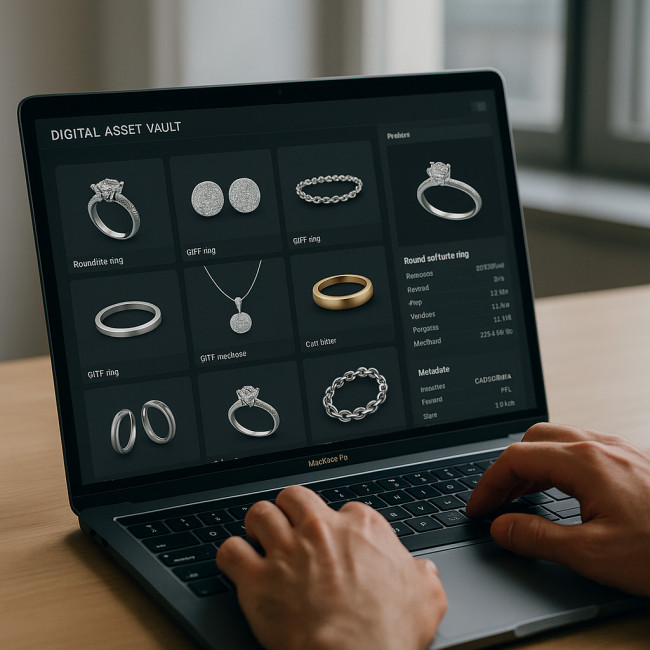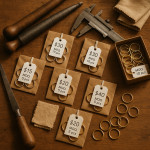Digital asset vault: organize 3D jewellery files for instant recruiter access
Waiting hours for heavy 3D renders to upload is the fastest way to lose a jeweller-hiring recruiter. Build a streamlined digital asset vault instead: your files load in seconds, metadata matches search filters and permissions stay watertight. Follow this guide to set up, secure and share your 3D jewellery files so decision-makers can shortlist you on the spot.
Why a digital asset vault is now mission-critical
Recruiters use directory platforms and virtual try-on demos to spot talent fast. If your STL, OBJ or FBX files live across random drives, you fail three core hiring criteria:
- Speed: long download times stall evaluation.
- Searchability: missing metadata hides you from filter-heavy portals.
- Compliance: unsecured files risk IP leaks that scare brands.
Core components of a high-performing digital asset vault
1. Predictive folder taxonomy
Mirror a recruiter's mental model. Top-level folders by collection year, sub-folders by piece type (ring, pendant, cuff) and final level by format (renders, 3D, tech pack).
2. Standardised file naming
Adopt a five-field slug: Brand_Collection_Piece_Material_Version.ext. Example: Aurist_Orbit_Ring_18kGold_v03.stl. Consistent slugs sync smoothly with platform imports such as the Artfolio craft-designer directory.
3. Rich metadata embedding
Embed material, weight and stone data inside the 3D file headers. Doing so lets algorithmic search surface your design when buyers tick “18 k recycled gold”—enhancing the impact of your eco-certificate claims.
4. Compression without quality loss
Use Draco or glTF binary to shrink file size by up to 90 % while keeping vertex normals intact. Faster previews equal faster callbacks.
5. Permission layers
Host your vault on a platform offering link-based roles: viewer (watermarked, low-poly), commenter (markup allowed) and downloader (full-res, password-locked).
Setting up your digital asset vault in 5 steps
- Select storage – Compare top contenders in the table below.
- Audit existing files – Discard duplicates, update legacy formats.
- Apply naming & metadata rules – Batch-process via scripts.
- Upload & set permissions – Share view-only links first.
- Integrate with directories – Sync thumbnails and glTF viewers.
| Cloud tool | Max file size | 3D preview | Versioning | Price / mo. |
|---|---|---|---|---|
| Dropbox Professional | 2 GB | Yes (Sketchfab plug-in) | 180 days | €19.99 |
| Google Drive + nViewer | 5 TB | Yes | 30 days | €9.99 |
| Microsoft OneDrive | 250 GB | No | 30 days | €6.99 |
| Autodesk Drive | Unlimited | Yes (native) | All versions | €14.90 |
Automate recruiter-friendly metadata
Manual tagging is slow. Leverage Python scripts or Adobe Bridge templates to inject:
- Material codes: 750AU, PT950.
- Carat & cut: 0.25ct VS1 Round.
- Manufacturing method: lost-wax cast, DMLS.
- Certifications: RJC CoC, Fairmined.
These fields align with directory filters used by brands sourcing recycled gemstones.
Embed interactive previews to win the first click
Recruiters skim hundreds of portfolios daily. A built-in glTF viewer or iframe makes your digital asset vault feel instantaneous. Combine this with photorealistic mock-ups to shorten approval cycles by 30 %.
Security checklist: keep IP intact
- Activate two-factor authentication on the vault.
- Apply watermarked low-poly previews for public viewers.
- Use file-level expiry links for one-off juries or buyers.
- Log every download event; export CSV for legal audits.
Turn your digital asset vault into a sales machine
Link vault URLs to directory buttons
Most online directories allow a “Download 3D” or “View in AR” button. Point these to your permissioned vault URLs. Results: higher shortlist rates and fewer back-and-forth emails.
Capture analytics data
Track file opens, time-in-viewer and zoom interactions. These micro-signals help you refine which designs to headline at the next buying season or the forthcoming Craft Week showcase.
Bundle assets for wholesale packs
Group CAD files, BOM sheets and render stills in zip bundles ready for manufacturers. This pre-emptive packaging accelerates factory feasibility checks, a tactic that complements profitable wholesale agreements.
Common roadblocks and quick fixes
- Mismatched units: Standardise to millimetres before upload.
- Colour shift in WebGL: Embed sRGB texture maps.
- Polycount too high: Decimate meshes to < 200 k without losing prong detail.
- Recruiter can't open file: Supply alternate STEP or IGES exports.
Quick self-assessment quiz
FAQ
- Can I host my digital asset vault on a personal server?
- Yes, but you'll need SSL certificates, daily backups and a 3D viewer stack. Most designers opt for managed cloud to avoid maintenance overhead.
- How do I prevent unauthorised 3D printing of my designs?
- Serve decimated, watermark-embedded meshes for previews and gate full-res downloads behind NDAs and expiring links.
- What's the minimum internet speed recruiters expect for loading a 5 MB glTF file?
- On a 25 Mbps connection, the file should appear in under two seconds. Test with throttling tools to hit this benchmark.
- Do directories charge extra to link external vaults?
- Most platforms include one external link slot in premium tiers. Check your plan's allowances before adding multiple vault URLs.
Conclusion: vault up and get booked faster

A strategically organised digital asset vault converts curiosity into contracts. When recruiters can spin, zoom and inspect your 3D jewellery within seconds, you leap ahead of designers stuck emailing ZIPs. Start today: audit files, apply naming rules, compress smartly and embed previews. Your next big commission could be one friction-free click away.
Ready to speed up recruiter approvals? Optimise one collection this week and measure how many extra shortlist notifications land in your inbox.











